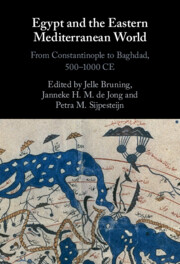Book contents
- Egypt and the Eastern Mediterranean World
- Egypt and the Eastern Mediterranean World
- Copyright page
- Contents
- Figures, Graphs, and Tables
- Notes on Contributors
- Notes on Transliteration, Names, and Dates
- Preface and Acknowledgments
- Additional material
- Introduction
- Part I Political and Administrative Connections
- Part II Economic Connections
- Part III Social and Cultural Connections
- Chapter 10 The Destruction of Alexandria: Religious Imagery and Local Identity in Early Islamic Egypt
- Chapter 11 Scribal Networks, Taxation, and the Role of Coptic in Marwanid Egypt
- Chapter 12 A Changing Position of Greek? Greek Papyri in the Documentary Culture of Early Islamic Egypt
- Chapter 13 Regional Diversity in the Use of Administrative Loanwords in Early Islamic Arabic Documentary Sources (632–800 CE): A Preliminary Survey
- Chapter 14 Babylon/Qaṣr al-Shamʿ: Continuity and Change at the Heart of the New Metropolis of Fusṭāṭ
- Chapter 15 Utilizing Non-Muslim Literary Sources for the Study of Egypt, 500–1000 CE
- Index
- References
Chapter 13 - Regional Diversity in the Use of Administrative Loanwords in Early Islamic Arabic Documentary Sources (632–800 CE): A Preliminary Survey
from Part III - Social and Cultural Connections
Published online by Cambridge University Press: 01 December 2022
- Egypt and the Eastern Mediterranean World
- Egypt and the Eastern Mediterranean World
- Copyright page
- Contents
- Figures, Graphs, and Tables
- Notes on Contributors
- Notes on Transliteration, Names, and Dates
- Preface and Acknowledgments
- Additional material
- Introduction
- Part I Political and Administrative Connections
- Part II Economic Connections
- Part III Social and Cultural Connections
- Chapter 10 The Destruction of Alexandria: Religious Imagery and Local Identity in Early Islamic Egypt
- Chapter 11 Scribal Networks, Taxation, and the Role of Coptic in Marwanid Egypt
- Chapter 12 A Changing Position of Greek? Greek Papyri in the Documentary Culture of Early Islamic Egypt
- Chapter 13 Regional Diversity in the Use of Administrative Loanwords in Early Islamic Arabic Documentary Sources (632–800 CE): A Preliminary Survey
- Chapter 14 Babylon/Qaṣr al-Shamʿ: Continuity and Change at the Heart of the New Metropolis of Fusṭāṭ
- Chapter 15 Utilizing Non-Muslim Literary Sources for the Study of Egypt, 500–1000 CE
- Index
- References
Summary
When the Arab armies conquered a territory of more than 13 million square miles extending between the Atlantic Ocean and present-day Afghanistan, they paved the way for the formation of new webs of transregional interaction. One of the most manifest traces of substratal cultural influences on the formation of the early Islamic imperial polity are the lexical borrowings that characterize Arabic documentary sources.1 These loanwords and foreign words2 not only reveal aspects of the historical development of Arabic but are also indicative of the wider formative environment of scribal practices in the early caliphate.
This study surveys the loan vocabulary in Arabic documentary evidence as an indicator of the social geography of the early Islamic empire.3 The question of intentionality or, in other words, the extent to which the use of loanwords in Arabic documents mirrors a conscious employment of foreign technical terminology will, however, remain beyond the scope of this contribution.
- Type
- Chapter
- Information
- Egypt and the Eastern Mediterranean WorldFrom Constantinople to Baghdad, 500-1000 CE, pp. 408 - 445Publisher: Cambridge University PressPrint publication year: 2022



